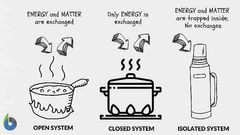![]()
![]()
![]()
Use LEFT and RIGHT arrow keys to navigate between flashcards;
Use UP and DOWN arrow keys to flip the card;
H to show hint;
A reads text to speech;
19 Cards in this Set
- Front
- Back
|
different subsystems that make upthe Earth |
Geosphere, Hydrosphere, Atmosphere and Biosphere |
|
|
set of interconnected components that are interacting to form aunified whole |
system |
|
|
How do the four systems interact? |
The first system, the geosphere, consists of the INTERIOR AND SURFACE OF EARTH, both of which are made up of rocks. The limited part of the planet that CAN SUPPORT LIVING THINGS comprises the second system; these regions are referred to as the biosphere. In the third system are the areas of Earth that are COVERED WITH ENORMOUS AMOUNTS OF WATER, called the hydrosphere. The atmosphere is the fourth system, and it is an envelope of gas that KEEPS THE PLANET WARM and PROVIDES OXYGEN FOR BREATHING and CARBON DIOXIDE FOR PHOTOSYNTHESIS. |
|
|
system in which there is only an exchange of heat or energy and NO EXCHANGE OF MATTER. |

closed system |
|
|
thin gaseous layer that envelopes the lithosphere |
atomosphere |
|
|
composition of the present atmosphere |
78% nitrogen (N), 21% oxygen (O2), 0.9% argon, and trace amount of other gases |
|
|
One of the most important processes by which the heat on the Earth's surface is redistributed |
atmospheric circulation |
|
|
a constant exchange of HEAT AND MOISTURE between theatmosphere and the hydrosphere |
hydrologic cycle |
|
|
includes the rocks of the crust and mantle, the metallicliquid outer core, and the solid metallic inner core. |
lithosphere |
|
|
set of all life forms on Earth; covers all ecosystems—from the soil to the rainforest, from mangrovesto coral reefs, and from the plankton-rich ocean surface to the deep sea |
biosphere |
|
|
base of the food chain |
photosynthetic organism |
|
|
Describe the process of photosynthesis |
CO2 is sequestered (separated) from the atmosphere, while oxygen is released as a by-product. |
|
|
a CO2 sink, and therefore, an important part of the carbon cycle |
biosphere |
|
|
about 70% of the Earth is covered with liquid water (hydrosphere) and much of it is in the form of OCEAN WATER |
hydrosphere |
|
|
Composition of water |
3% is fresh: TWO-THIRDS is ice, and the REMAINING ONE-THIRD is present in streams, lakes, and groundwater. |
|
|
important sinks for CO2 through DIRECT exchange with theatmosphere and INDIRECTLY through the weathering of rocks. |
oceans |
|
|
Heat is absorbed and redistributed on the surface of the Earth through____ |
ocean circulation |
|
|
a graphical representation of the proportion of land at various elevations (meters above or below sea level) |
hypsographic curve |
|
|
Through the process of weathering and erosion, this is anotherimportant process contributing to the shaping and reshaping of the surface of the Earth. This is an IMPORTANT LINK among the hydrosphere, atmosphere, and lithosphere that the learners should be able to identify themselves |
hydrologic cycle |

